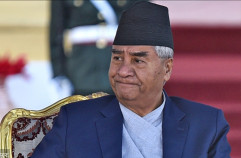A new generation in Madhavanarayan
We use Google Cloud Translation Services. Google requires we provide the following disclaimer relating to use of this service:
This service may contain translations powered by Google. Google disclaims all warranties related to the translations, expressed or implied, including any warranties of accuracy, reliability, and any implied warranties of merchantability, fitness for a particular purpose, and noninfringement.


18-year-old Ritesh Maharjan of Lalitpur Thechwa, who has a feta tied on his head, is seen moving forward as a symbol of Brahma with a lamp on his shoulder, kum, hand and head. 25-year-old Savir Maharjan of Thechwa is in the avatar of Vishnu. Thousands of streams are flowing from the chhwali that he is carrying in a dhoti. Shree Jal Maharjan seen in the symbol of Maheshwar is sitting on Jasi (Khadkulo) blowing conch and sprinkling water.


This is the scene seen at the recently concluded Madhavanarayan Utsav in Thechwa. The participants of the festival decorate their body with ornaments such as Bhipu, Bapucha, Sikh and other garlands. During the festival, some youths carry the figure of Ravana made of paper on a stick to circumambulate the city, while others carry the idol of Mahadev and carry it to Jatra. In the meantime, the traditional songs of Mahadev, Buddha, Krishna, Mahabharata sung by playing harmonium and tabla add more excitement.
Madhava Narayan festival is specially celebrated every year on Godavari-12 Thechwa in Lalitpur. In other places of the valley, the custom of celebrating Brahma, Vishnu and Maheshwar has been stopped. But in Thechu, the young generation is also following this tradition. Ritesh participated in the Madhavanarayan festival for the third time as the symbol of Brahma. Savir has participated in the Madhavanarayan festival 9 times as Brahma, Vishnu and Maheshwar. Sreejal took the experience for the first time. Madhavnarayan's fast is very strict. Ritesh says that after suffering and completing the fast, the self-satisfaction of the body becomes pure, that's why I have been participating in the festival every year.
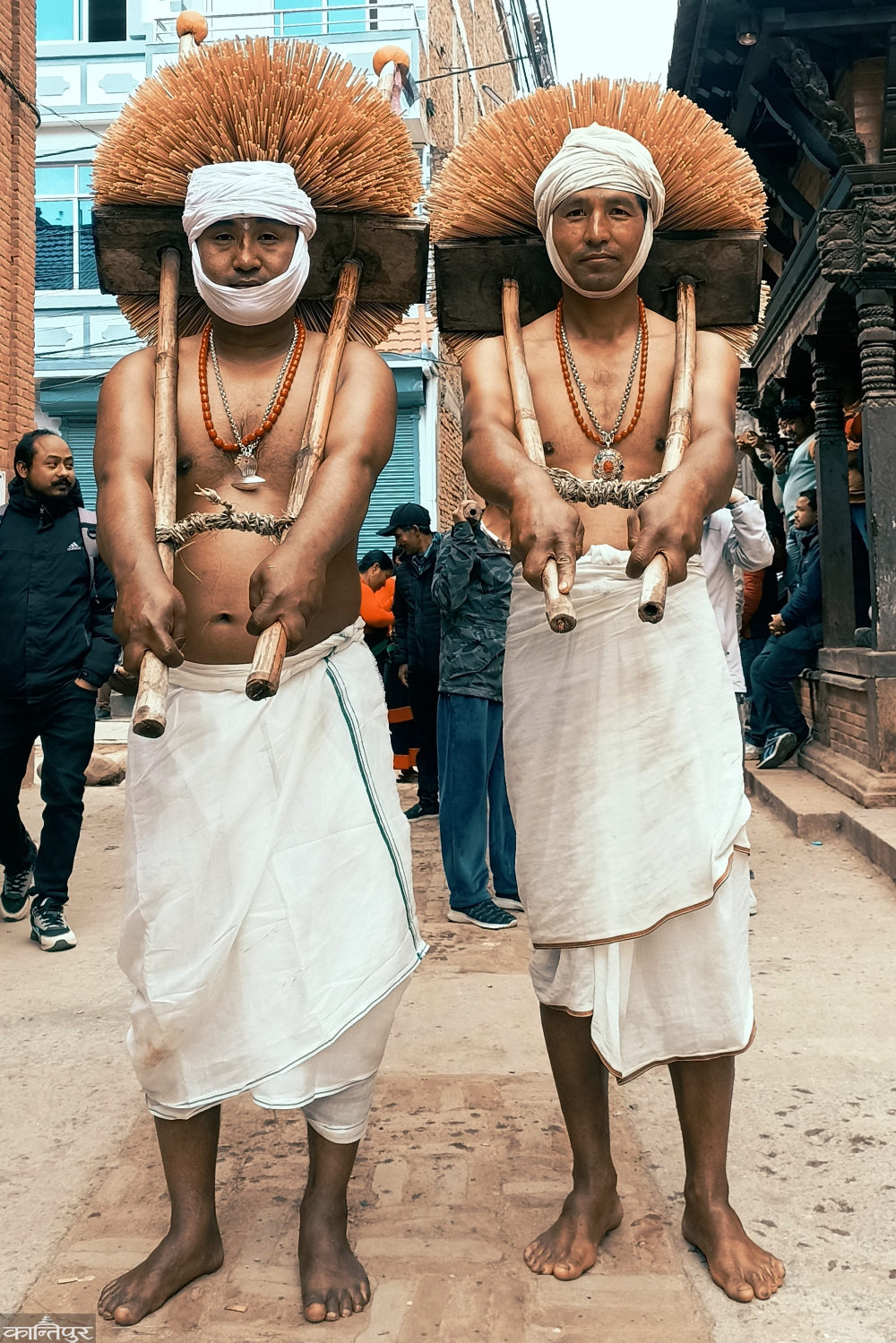 Savir says that he is also participating in the festival to raise awareness about the cultural significance of the Madhavanarayan festival. Savir's father Kanchakumar Maharjan is a leader of Thechwa Magh Mahatmya Sangh. Sabir says that while the trend of embracing foreign cultures is increasing, the youth need to be aware of preserving their traditions and customs. Krishna Mali of Thechwa, who participates in the
Savir says that he is also participating in the festival to raise awareness about the cultural significance of the Madhavanarayan festival. Savir's father Kanchakumar Maharjan is a leader of Thechwa Magh Mahatmya Sangh. Sabir says that while the trend of embracing foreign cultures is increasing, the youth need to be aware of preserving their traditions and customs. Krishna Mali of Thechwa, who participates in the
festival every year, has been fasting for a month to participate in the festival. Mali said that cultural traditions not only teach how to live life but also develop a sense of harmony among each other. Madhavanarayan Parva is a month long festival dedicated to Lord Vishnu. Every year, from Marg Shukla Paksha Purnima to February Shukla Purnima, every day in the morning is celebrated by bathing and taking conch water, blowing conch and reciting the glory of Mahadev.
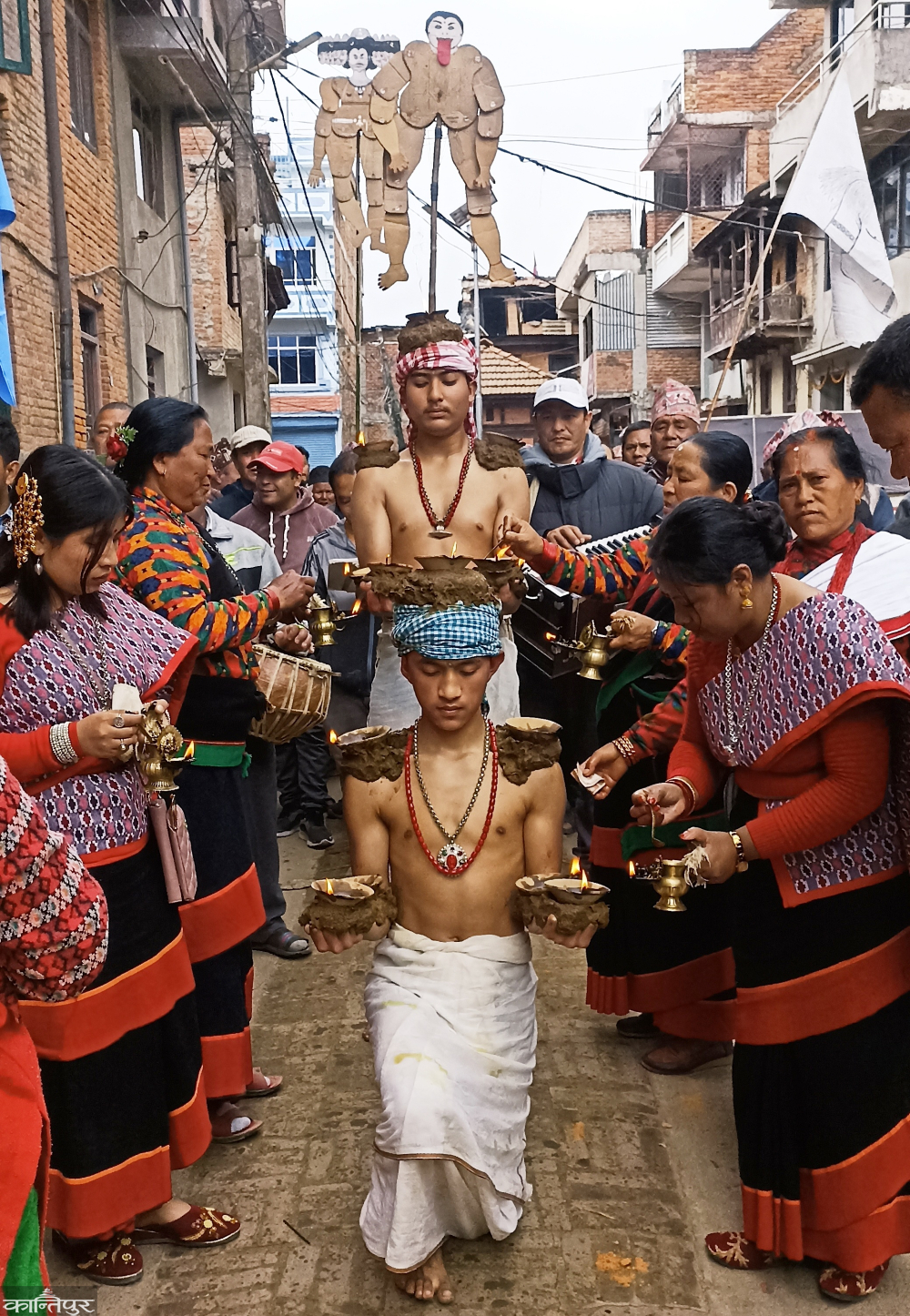 In Sankhu, it is customary to take the statue of Madhavnarayan on foot through Bhaktapur's Triveni Ghat via Kavre, Changunarayan, Pashupatinath and Farping Sesha Narayan and finally reach Sankhu. Trivenighat at Hanumanghat in Bhaktapur is also observed for one month Madhavnarayan fast. In Bhaktapur, it is a tradition for the fasting people to reach Taleju Bhavani, Panauti, Pashupatinath, Changunarayan Sankhadah, bathe, have a darshan of Changunarayan along with the Kalash and end the fast by offering the Indra Kalash to the statue of Bhupatindra Malla.
In Sankhu, it is customary to take the statue of Madhavnarayan on foot through Bhaktapur's Triveni Ghat via Kavre, Changunarayan, Pashupatinath and Farping Sesha Narayan and finally reach Sankhu. Trivenighat at Hanumanghat in Bhaktapur is also observed for one month Madhavnarayan fast. In Bhaktapur, it is a tradition for the fasting people to reach Taleju Bhavani, Panauti, Pashupatinath, Changunarayan Sankhadah, bathe, have a darshan of Changunarayan along with the Kalash and end the fast by offering the Indra Kalash to the statue of Bhupatindra Malla.
Shri Brahmayani Cultural Manka Khal: According to Ichha Maharjan, President of Magha Mahatma Sangh Thechwa, along with the development of Vagmati civilization, the life style of the Newar community started to worship God in 9 ways. "It seems that Magha Mahatmya has had a great influence on the life style and philosophy of Newars affected by Navadha Bhakti," he said, "The sutras of Navadha Bhakti which have disappeared elsewhere are alive in Thechva."
Maharjan said that he tried hard to save the culture when he was young, but now this responsibility has fallen on the shoulders of the youth. "The man who lives in Khadkula is a symbol of Mahadev who reaches Gosaikund after consuming Kalkut poison and meditates," he said, "carrying a chhwali means to flow thousands of streams, while putting a lamp on the head means lighting a lamp to the sun god as a sign of respect."
According to Hindu tradition, twelve months It is customary to worship one Narayan in every month. Madhusudan Narayan is worshiped in Baisakh, Trivikram in June, Vaman in Asar, Sridhar in August, Rishikesh in Bhadra, Padmanabha in August, Damodar in Kattik, Keshava in November, Narayan in Pus, Madhava in Magha, Govinda in February and Vishnu Narayan in Chait. Just like the name of Narayan changes every month, the conch, chakra, mace and padma that are in the four arms of Narayan also change. In Magha there is chakra, conch shell on the right side and mace and padma on the left side.
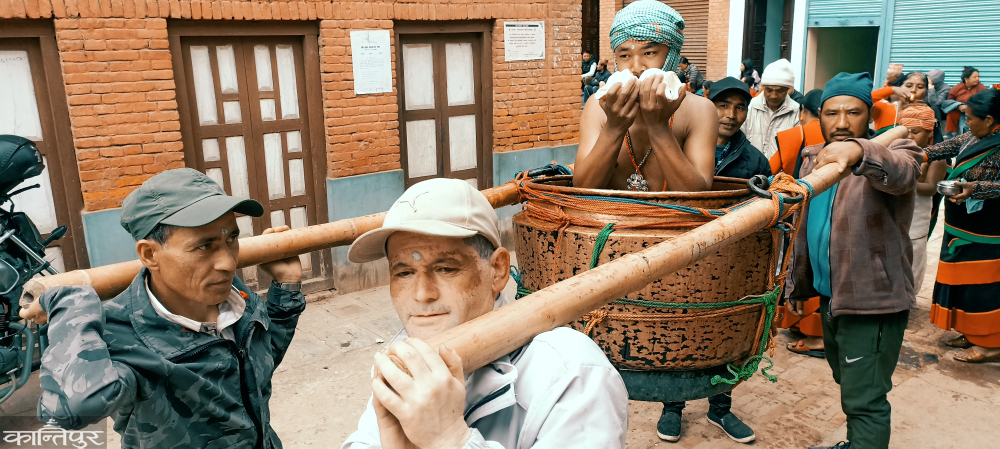 At this time, it is believed that if the devotees bathe every day and do daily worship, chanting, penance, meditation, listening to the sound of the sun, and worshiping the goddess including Shiva Parvati, their wishes will be fulfilled. Married women fast and pray for a prosperous life and longevity of their spouse, while unmarried women wish for a worthy life partner.
At this time, it is believed that if the devotees bathe every day and do daily worship, chanting, penance, meditation, listening to the sound of the sun, and worshiping the goddess including Shiva Parvati, their wishes will be fulfilled. Married women fast and pray for a prosperous life and longevity of their spouse, while unmarried women wish for a worthy life partner.
but the content is somewhat different from other places. On Shuklapaksha Saptami of February, in the early morning, Lord Mahadev is worshiped and 7 types of worship materials including barley, corn, rice, black sesame are kept and lamp lights are offered in the Nakkhu river. A kind of dried fruit bark is cut into small pieces and a hole is cut in the middle and itamat (lamp) is floated in the Bali river. It is believed that longing and ambitions will be fulfilled if the light spread in this way goes far.
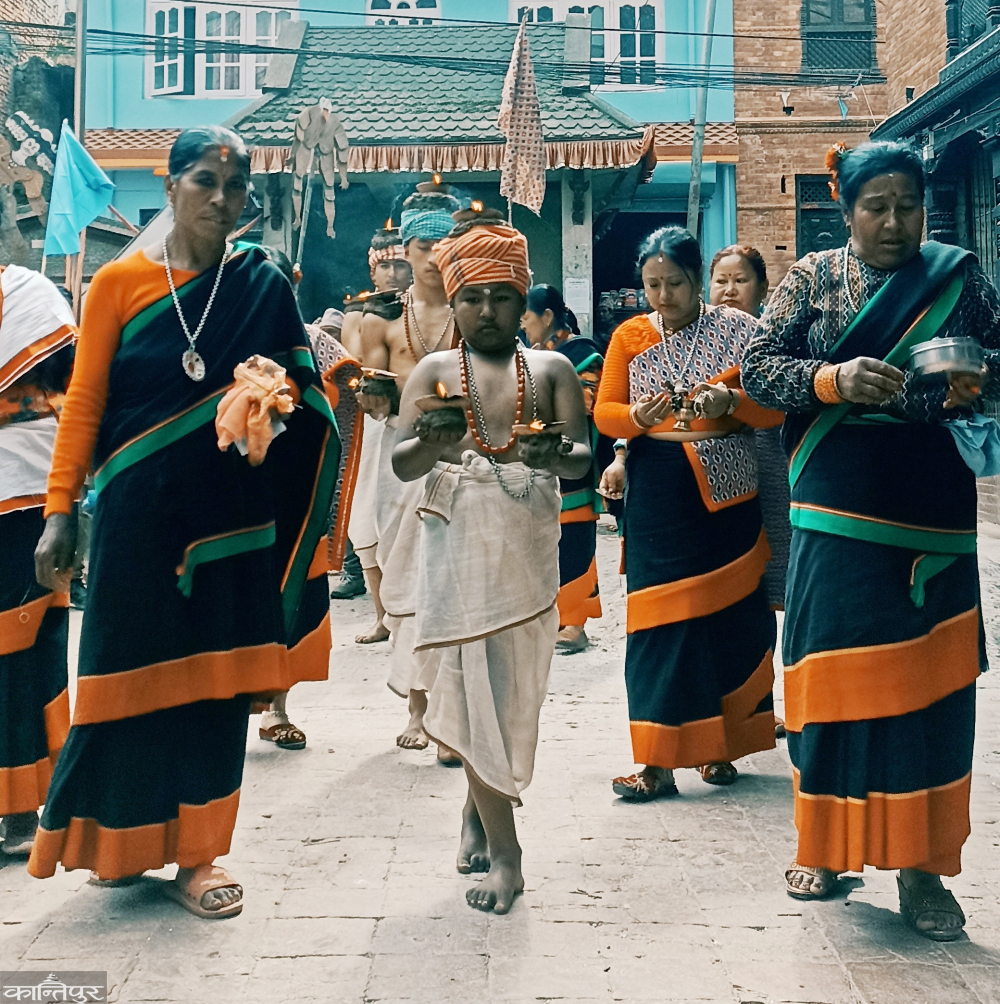 On this day, the people of Thechuva go to the bank of the Nakhkhu river and eat knife and khir bhat. This day is called 'Lagala Chuykegu' in Nepali language. On both the days, Shivlinga is kept in Khat and taken around the city. It is described in the Srisvasthani story that the sun is in Makara at this time, and bathing in Prabhas will be good for a person. It is a tradition that a person observing the fast of Madhavnarayan should fast one day before the start of the fast, bathe in Triveni in the morning and pray, take conch water and recite mantras, after taking conch water, do not touch anyone and do not wear shoes. After completing the
On this day, the people of Thechuva go to the bank of the Nakhkhu river and eat knife and khir bhat. This day is called 'Lagala Chuykegu' in Nepali language. On both the days, Shivlinga is kept in Khat and taken around the city. It is described in the Srisvasthani story that the sun is in Makara at this time, and bathing in Prabhas will be good for a person. It is a tradition that a person observing the fast of Madhavnarayan should fast one day before the start of the fast, bathe in Triveni in the morning and pray, take conch water and recite mantras, after taking conch water, do not touch anyone and do not wear shoes. After completing the
Nagar Parikram, it is customary to feed them with knife, chiura, ginger and ghee. According to Guru Dashlal Maharjan of Brahmayani Magh Mahatmya Sangh, it was organized by each village during the Malla period. Till 40 years ago, five villages used to organize separate festivals in Thechu. At that time, there was competition between toltols. Now Zenten is in operation," he said.
प्रकाशित : चैत्र ५, २०८० ०७:४६
 २५.१२°C काठमाडौं
२५.१२°C काठमाडौं







